Приказ основних података о дисертацији
Opekarska delatnost VII Klaudijeve legije
Ceramic building material production of the 7th Claudian legion
| dc.contributor.advisor | Vujović, Miroslav | |
| dc.contributor.other | Šarić, Kristina | |
| dc.contributor.other | Cvijetić, Jelena | |
| dc.creator | Jevtović, Ljubomir | |
| dc.date.accessioned | 2024-03-13T15:47:37Z | |
| dc.date.available | 2024-03-13T15:47:37Z | |
| dc.date.issued | 2023-09-08 | |
| dc.identifier.uri | https://uvidok.rcub.bg.ac.rs/doccall/bitstream/handle/123456789/5371/Referat.pdf | |
| dc.identifier.uri | https://eteze.bg.ac.rs/application/showtheses?thesesId=9533 | |
| dc.identifier.uri | https://fedorabg.bg.ac.rs/fedora/get/o:32932/bdef:Content/download | |
| dc.identifier.uri | https://plus.cobiss.net/cobiss/sr/sr/bib/124303369 | |
| dc.identifier.uri | https://nardus.mpn.gov.rs/handle/123456789/22298 | |
| dc.description.abstract | Predmet istraživanja ove doktorske disertacije je opekarska delatnost VII Klaudijeve legije. Analizirano je 1.391 opeka sa žigom i grafitnim natpisom ove vojne jedinice sa arheoloških nalazišta Srbije, Hrvatske, Rumunije i Bugarske, kao i ostaci 9 ciglana iz Viminacijuma. Opšti cilj disertacije je doprinos boljem razumevanju opekarske delatnosti i organizacije VII Klaudijeve legije. Ovo je podrazumevalo utvrđivanje asortimana keramičkih građevinskih proizvoda VII Klaudijeve legije, njihovih morfoloških i morfometrijskih karakteristika, tehnoloških aspekata i sleda operacija njihove izrade (od izbora i karakteristika sirovina, preko tehnika njihove obrade, oblikovanja i obeležavanja, uključujući i alatke, do pečenja), lociranje mesta proizvodnje i određivanje prostorne organizacije ciglana i karakteristika i namene proizvodnih objekata i struktura. Rezultati istraživanja pokazuju da VII Klaudijeva legija primarno proizvodi oblike koji se češće koriste u građevini (besalis, lidion, tegule i imbreksi) i da su dimenzije opeka standardizovane, ali da postoje varijacije, kao i da se menjaju kroz vreme. Traseološka i komparativna analiza opeka su pokazale da su sled operacija, tehnike formiranja opeka i opekarske alatke uniformni na nivou Carstva, ali uz određena odstupanja. Arheometrijskim metodama utvrđeno je da su opeke pravljene od gline dobrog i generalno ujednačenog kvaliteta, ali da postoje određene oscilacije, dok temperatura pečenja uglavnom nije prelazila 800 (850) oC. Dodatno, utvrđeno je da su centri proizvodnje bili u Tilurijumu (Hrvatska), Racijariji (Bugarska) i Viminacijumu (Srbija), ali da se proizvodnja odvijala i na drugim lokalitetima – Boljetinu i Talijati. Konačno, istraživanje je pokazalo da ciglane VII legije pripadaju većim radionicama i da ih odlikuje organizovana proizvodnja i složeni prostorni raspored, ali da ne postoji pravilnost u prostornoj organizaciji, već da su organizovane na način koji pogoduje toku proizvodnje i lokalnim uslovima. | sr |
| dc.description.abstract | The thesis deals with the ceramic building material production of the 7th Claudian legion. The analysis was conducted on 1.391 stamped bricks and tiles from the territory of Serbia, Croatia, Romania and Bulgaria, as well as on the remains of nine brick workshops from Viminacium. The overarching goal of the thesis was to add to the sum of knowledge on ceramic building material production and the organization of the 7th legion. This included the determination of the products of the legion, their morphological and morphometric characteristics; technological aspects of the production and chain of operations (choice and characteristics of the raw materials, their treatment, shaping and marking, tools and baking); identification of workshop locations, their spatial organization and characteristics of production facilities. The results of the study show that Legio VII Claudia primarily focused its production on the main brick and tile forms used in architecture, whose dimensions were standardized, although there are discrepancies and temporal changes. The analysis of traces of production on bricks and tiles and the following comparative analysis have shown that the chain of operations and production technology were uniform throughout the Empire, but that there are some specificities. The archaeometric analysis has shown that bricks and tiles were made using well–graded and generally uniform clay, although with some deviances, as well as that the firing temperature did not exceed 800 (850) oC. The results of the archaeometric and spatial analysis testify that the main brickworks of the Legion were located in Tilurium (Croatia), Ratiaria (Bulgaria) and Viminacium (Serbia), but that the production was organized on other sites, such as Boljetin and Taliata. Finally, the research has shown that the CBM workshops of the legion had a large–scale production. They are characterised by organized production and complex spatial organization, with objects and structures positioned in a way to facilitate workflow depending on the local conditions. | en |
| dc.format | application/pdf | |
| dc.language | sr | |
| dc.publisher | Универзитет у Београду, Филозофски факултет | sr |
| dc.rights | openAccess | en |
| dc.rights.uri | https://creativecommons.org/licenses/by-nc-nd/4.0/ | |
| dc.source | Универзитет у Београду | sr |
| dc.subject | rimski period, provincijalna arheologija, rimske vojne jedinice, VII Klaudijeva legija, rimska ekonomija, rimsko opekarstvo, keramički građevinski materijali, rimske ciglane | sr |
| dc.subject | roman period, provincial archaeology, roman army, 7th Claudian legion, roman economy, ceramic building materials, bricks and tiles, roman ceramic workshops, roman brick kilns | en |
| dc.title | Opekarska delatnost VII Klaudijeve legije | sr |
| dc.title.alternative | Ceramic building material production of the 7th Claudian legion | en |
| dc.type | doctoralThesis | |
| dc.rights.license | BY-NC-ND | |
| dc.identifier.fulltext | http://nardus.mpn.gov.rs/bitstream/id/159910/Disertacija_15119.pdf | |
| dc.identifier.fulltext | http://nardus.mpn.gov.rs/bitstream/id/159911/Izvestaj_Komisije_15119.pdf | |
| dc.identifier.rcub | https://hdl.handle.net/21.15107/rcub_nardus_22298 |



